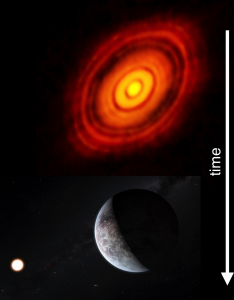Formation & Evolution
Introduction
Project Leader: Prof. Willy Benz
Together with the observations shifting their focus from discovery to characterisation of exoplanets, a similar transition needs to be achieved in the theory of planet formation and evolution. Planets should no longer be characterized by only a few basic properties (e.g. mass, orbit), but should be considered as objects with structures (e.g. core, mantle, surface, atmosphere), whose properties and interactions need to be investigated. For this, one has to consider the complex interplay between formation, during which planets acquire their bulk properties, and evolution that ultimately determines their present characteristics and their potential habitability.
The goal of this project and the companion project “Numerical Laboratories” is to develop integrated theoretical planet formation-evolution models with the aim at being able to describe the physical and chemical conditions on the surface of exoplanets. Practically, the work to be performed has been divided in two sub-projects.
From planet formation to mature planets
(top: protoplanetary Disk of HL Tauri; bottom: artist impression of the rocky super_Earth HD 85512b) (Credit: ALMA and ESO)
Sub-projects
Global structure of planetary systems – A statistical approach
Prof. Yann Alibert
In this sub-project the planetary system is considered globally with the aim at predicting/understanding mean or bulk properties such as masses, orbital parameters, mean density (or total radius), mean composition (not considering the possible partitioning of elements between atmosphere and core), luminosity, etc… For this multi-dimensional synthetic end-to-end planet formation and evolution models will be developed.
Characteristics of planets: Internal structure and atmosphere
Prof. Kevin Heng
In this sub-project, the focus is on a detailed characterisation of the exoplanets, whose global properties will be computed as a result of sub-project 1. The ultimate aim is to characterise the surface properties of individual exoplanets. For this, the dynamics and bulk composition of exoplanet atmospheres, taking into account atmosphere-interior exchanges as well as atmospheric loss due to evaporation, will be computed.


